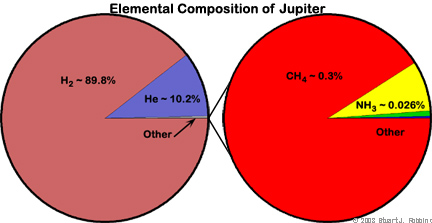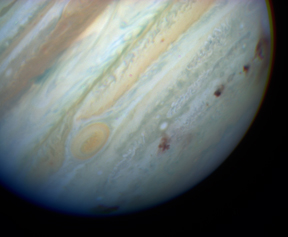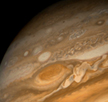Jupiter
Jupiter's Moons

Jupiter is a gas giant. This means that it has a huge atmosphere,
a liquid mantle, and a liquid / solid core, with no definite boundary between
the layers.
The core of Jupiter is probably composed of liquid rock, at
a temperature as high as 24,000 K (43,000 °F). The core is small relative
to the planet, about 20% of its radius, but it is still fifteen times heavier
than the Earth.
Next comes a layer of liquid hydrogen that is under the pressure
of 10,000,000 Earth atmospheres. This changes the nature of the hydrogen in such
a way that it is able to conduct electricity as metal does, so it is called "metallic
hydrogen." This generates the planet's magnetic field which is 20,000 times
stronger than Earth's. This layer also makes up most of the planet
The layer on top of this is ordinary liquid hydrogen. This
composes the upper 25% of the planet.
Next, the hydrogen thins out into the gaseous atmosphere which
is 1000 km (620 miles) deep. It is composed mainly of hydrogen and helium with
trace amounts of methane, water, ammonia, and hydrogen sulfide. Some scientists
believe that there are also polysulphur compounds and phosphine which lend their
colors to the clouds.
Jupiter also has a faint ring system. It is comprised of one
main ring, with fuzzier "gossamer" rings farther out. The system is
only a few thousand kilometers from the sharp outer edge to the inner fuzzy edge
which continues to the planet's atmosphere. The picture at left was taken by
the Galileo spacecraft when the sun was
behind Jupiter, so the rings were backlit.
 Jupiter
is basically one big atmosphere - as far as we know, there is no real surface
to the planet. Because it is too small to be a star, no processes of fusion exist
to change its composition as has occurred in the sun. Many astronomers believe
that Jupiter's composition reflects the initial composition of the solar
nebula. Its composition is nearly all H2; the rest is approximately: Jupiter
is basically one big atmosphere - as far as we know, there is no real surface
to the planet. Because it is too small to be a star, no processes of fusion exist
to change its composition as has occurred in the sun. Many astronomers believe
that Jupiter's composition reflects the initial composition of the solar
nebula. Its composition is nearly all H2; the rest is approximately:
- H2: 89.8±2.0%
- He: 10.2±2.0%
- CH4: 0.3±0.1%
- NH3: 0.026±0.004%
- HD: 0.0028±0.001%
- C2H6: 0.00058±0.00015%
- H2O: 0.0004% (varies with pressure)
Besides this, aerosols of ammonia ice, water ice, and ammonia
hydrosulfide exist in the atmosphere.
The temperature at 1 bar is approximately 165 K, and at 0.1
bar it is 112 K. The density at 1 bar is 160 g/m3. Below 30° latitude,
wind speeds range up to 150 m/s, and above that only 40 m/s. The scale height
of the Jovian atmosphere is about 27 km.

On March 25, 1993, comet P/Shoemaker-Levy
9 was discovered. Orbital calculations soon showed that it was on an impact course
with Jupiter. Impact was predicted to take place during a 5 1/2 day period in
July 1994.  The comet fractured into abour two dozen pieces between 1992
to its final impact in 1994; when it was initially discovered, it was determined
that there were 20 fragments. The comet was believed to have originally been
a 2.3 km diameter body that was broken and captured by Jupiter during a close
encounter in 1992. The comet fractured into abour two dozen pieces between 1992
to its final impact in 1994; when it was initially discovered, it was determined
that there were 20 fragments. The comet was believed to have originally been
a 2.3 km diameter body that was broken and captured by Jupiter during a close
encounter in 1992.
The first fragment, A, impacted at 05:32 EDT on July 16, 1994,
and the barrage of other fragments continued for another six days. The impacts
caused giant atmospheric disturbances, as evidenced by the true-color HST image
on the right. This image shows the folowing impact spots, from left to right:
E/F, H, N, Q1, Q2, R, and D/G. The original image had a resolution better than
200 km/px, and it is a 3-color composite of images at 9530 Å, 5500 Å, and 4100
Å.
Jupiter has several unique characteristics:
 The
first one is its immense size. It is indeed, as its name suggests, the king
of the planets. About 1,320 Earths could fit inside of it. The
first one is its immense size. It is indeed, as its name suggests, the king
of the planets. About 1,320 Earths could fit inside of it.- The second characteristic is the Great Red Spot. This is a gigantic (three
Earth diameters) storm that has existed for more than three centuries (Galileo discovered
it in the seventeenth century). It will probably continue to exist for hundreds
or thousands of years, for it is constantly being fed by smaller eddies surrounding
it, such as the white spots in the picture at the right.
- The third characteristic is its many moons.
Jupiter has the most moons of any planet in the solar system: .
- Another interesting property of Jupiter is how it generates heat. As seen
in the table below, the average temperature of Jupiter is approximately 160
K. However, due to the equation for thermal equilibrium (below), it should
only be about 100 K. This extra heat is generated due to gravitational contraction
- the planet is slowly shrinking in diameter. This way, by compressing by only
a few millimeters every year, it can generate heat by increasing the pressure
of its constituent gas.

- Pioneer 10 - 1 flyby in 1973
- Pioneer 11 - 1 flyby in 1974
- Voyager 1 - 1 flyby in 1979
- Voyager 2 - 1 flyby in 1979
- Galileo - orbited from 1995-2003
- Ulysses - Jupiter flyby in 1992
Jupiter is named after the Roman god of lightning, who was
also the King of the gods. Jupiter is definitely king over the planets, for it
is so big that the next-smallest planet, Saturn, could
fit in it more than one and one half times.
|
|
|
|
|
|
| Jupiter's Equator |
71,492
|
1.000
|
N/A
|
N/A
|
N/A
|
| Halo |
100,000 - 122,000
|
1.40 - 1.71
|
3x10-6
|
|
|
| Main |
122,000 - 129,000
|
1.71 - 1.81
|
5x10-6
|
0.015
|
|
| Gossamer (Inner) |
129,200 - 182,000
|
1.81 - 2.55
|
1x10-7
|
|
|
| Gossamer (Outer) |
182,000 - 224,900
|
2.55 - 3.15
|
|
|
|
|
| Perihelion (106 km) |
46.00 |
107.5 |
147.09 |
206.62 |
740.52 |
1352.55 |
2741.30 |
4444.45 |
| Mean Orbital Distance (106 km) |
57.91 |
108.2 |
149.60 |
227.92 |
778.57 |
1433.53 |
2872.46 |
4495.06 |
| Aphelion (106 km) |
69.82 |
108.9 |
152.10 |
249.23 |
816.62 |
1514.50 |
3003.62 |
4545.67 |
| Average Orbital Velocity (km/s) |
47.87 |
35 |
29.78 |
24.13 |
13.07 |
9.69 |
6.81 |
5.43 |
| Orbital Inclination (from
Earth's Orbit) |
7.00° |
3.4° |
0.0° |
1.850° |
1.304° |
2.485° |
0.772° |
1.769° |
| Orbital Eccentricity |
0.2056 |
0.007 |
0.0167 |
0.0935 |
0.0489 |
0.0565 |
0.0457 |
0.0113 |
| Equatorial Radius (km) |
2439.7 |
6051.8 |
6378.1 |
3397 |
71,492 |
60,268 |
25,559 |
24,764 |
| Polar Radius (km) |
2439.7 |
6051.8 |
6,356.8 |
3375 |
66,854 |
54,364 |
24,973 |
24,341 |
| Volume (1010 km3) |
6.083 |
92.843 |
108.321 |
16.318 |
143,128 |
82,713 |
6833 |
6254 |
| Ellipticity (Variation from
Sphere) |
0.0000 |
0.000 |
0.00335 |
0.00648 |
0.06487 |
0.09796 |
0.02293 |
0.01708 |
| Axial Tilt (from Earth's geographic
North) |
0.01° |
177.4° |
23.45° |
25.19° |
3.13° |
26.73° |
97.77° |
28.32° |
| Mass (1024 kg) |
0.3302 |
4.87 |
5.9736 |
0.64185 |
1898.6 |
568.46 |
86.832 |
102.43 |
| Density (water=1) |
5.427 |
5.243 |
5.515 |
3.933 |
1.326 |
0.687 |
1.27 |
1.638 |
| Escape Velocity (km/s) |
4.3 |
10.36 |
11.19 |
5.03 |
59.5 |
35.5 |
21.3 |
23.5 |
| Gravity (m/s2) |
3.70 |
8.802 |
9.78 |
3.716 |
23.1 |
9 |
8.7 |
11 |
| Surface Pressure (bars) |
≈ 10-15 |
92 |
1.014 |
0.000636 |
N/A |
N/A |
N/A |
N/A |
| Total Mass of Atmosphere (kg) |
< 1000 |
4.8x1020 |
5.1x1018 |
2.5x1016 |
N/A |
N/A |
N/A |
N/A |
| Sidereal Rotation Period (hours) |
1407.6 |
-5832.5 |
23.9345 |
24.6229 |
9.9250 |
10.656 |
-17.24 |
16.11 |
| Length of Day (hours) |
4222.6 |
2802 |
24 |
24.6597 |
9.9259 |
10.656 |
17.24 |
16.11 |
| Tropical Orbital Period (days) |
87.968 |
224.7 |
365.256 |
686.980 |
4330.595 |
10,746.94 |
30,588.740 |
59,799.9 |
| Bond
Albedo |
0.119 |
0.750 |
0.306 |
0.250 |
0.343 |
0.342 |
0.300 |
0.290 |
| Visual
Geometric Albedo |
0.106 |
0.65 |
0.367 |
0.150 |
0.52 |
0.47 |
0.51 |
0.41 |
| Visual
Magnitude |
-0.42 |
-4.40 |
-3.86 |
-1.52 |
-9.40 |
-8.88 |
-7.19 |
-6.87 |
| Solar
Irradiance (W/m2) |
9126.6 |
2613.9 |
1367.6 |
589.2 |
50.50 |
14.90 |
3.71 |
1.51 |
| Black-Body
Temperature (K) |
442.5 |
231.7 |
254.3 |
210.1 |
110.0 |
81.1 |
58.2 |
46.6 |
| Average
Surface Temperature (Celsius) |
167° |
464° |
15° |
-65° |
-110° |
-140° |
-195° |
-200° |
| Number
of Moons |
|
|
|
|
|
|
|
|
| Rings? |
No |
No |
No |
No |
Yes |
Yes |
Yes |
Yes |
| Global
Magnetic Field Strength (Gs) / Tilt |
0.0033 / 169° |
- / - |
0.3076 / 11.4° |
- / - |
4.28 / 9.6° |
0.210 / <1° |
0.228 / 58.6° |
0.142 / 46.9° |
| Discoverer |
Unknown |
Unknown |
Unknown |
Unknown |
Unknown |
Unknown |
William Herschel |
Johann Gottfried Galle |
| Discovery
Date |
Prehistory |
Prehistory |
Prehistory |
Prehistory |
Prehistory |
Prehistory |
March 13, 1781 |
September 23, 1846 |

|



